LINKS
TRAINING
RAILWAY DESIGN PLANS
Engine House
Car Shop
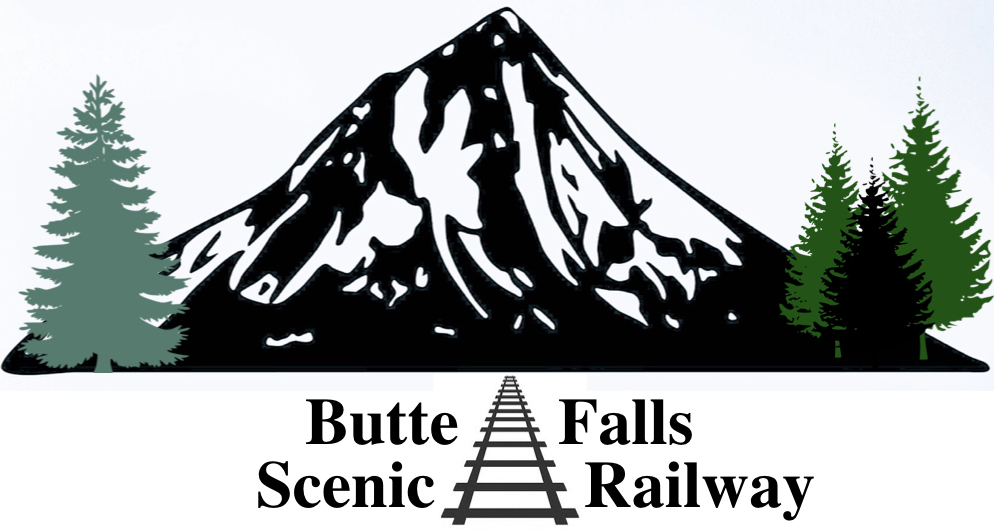
From a vision in 1889 to abandonment in 1962 the Butte Falls line was managed by 8 different organizations.
The Medford and Crater Lake Railroad
● The Medford and Crater Lake Railroad was organized by Medford banker A.A. Davis in 1904. The railroad planned
to build the line from Medford to Crater Lake but never got past Eagle Point.
● A ground breaking ceremony took place in Medford on April 4, 1905.

Mrs. Davis, wife of banker A.A. Davis, lifts the first shovel of earth in the ground-breaking ceremony. The Medford school band was also on hand. Mule teams were on hand to start grading immediately at the conclusion of the ceremony, (Southern Oregon Historical Society #10569 & #4582)
● Track Construction was completed to Eagle Point (11.7 miles)
by December 1, 1905
Crews of contract laborers imported from British India (Sikhs) were used in the construction of the line from Medford. (Southern Oregon Historical Society #01603)
● By 1906 the line was in financial difficulty and construction was halted.
● On February 2, 1906 the Medford and Crater Lake Railroad went
into receivership.
● After a succession of owners, the line was acquired by James J.
Hill’s Spokane, Portland, and Seattle Railroad (SP&S).
● Under the SP&S the line was renamed the Pacific and Eastern Railroad.
The Pacific and Eastern Railroad
● The Pacific & Eastern Railroad was incorporated in May of 1907 financed by W. Stryker & Alexander Sweek both of Portland. The road was to be managed by George Estes. Because of continuing financial difficulties the railroad changed ownership four times between 1907 and 1910. During this period construction continued toward Butte Falls. In June of 1910 James Hill, President of the Great Northern Railway took over the P&E. John F. Stevens was elected president of the P&E and is now head of all Hill roads that are strictly Oregon properties.


Pacific and Eastern Railroad survey crew (Southern Oregon Historical Society #33972)
Pacific and Eastern Railroad trestle construction (Southern Oregon Historical Society #88549)
● Construction of the rail line into Butte Falls was completed on November 15, 1910.
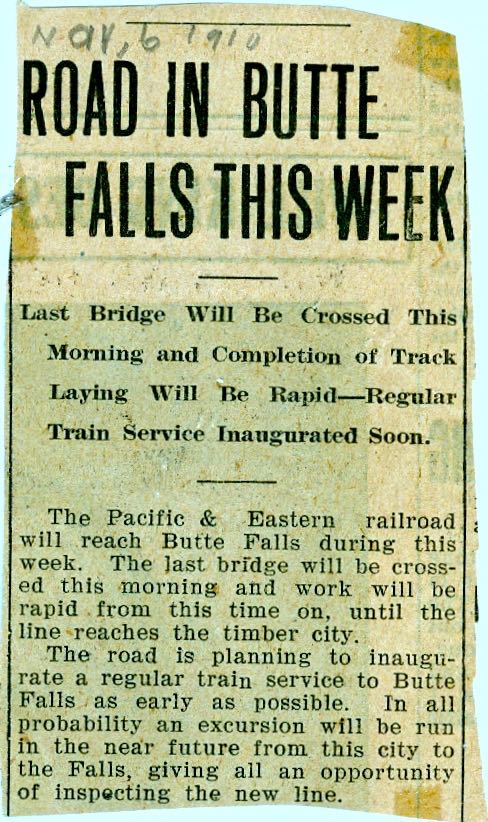
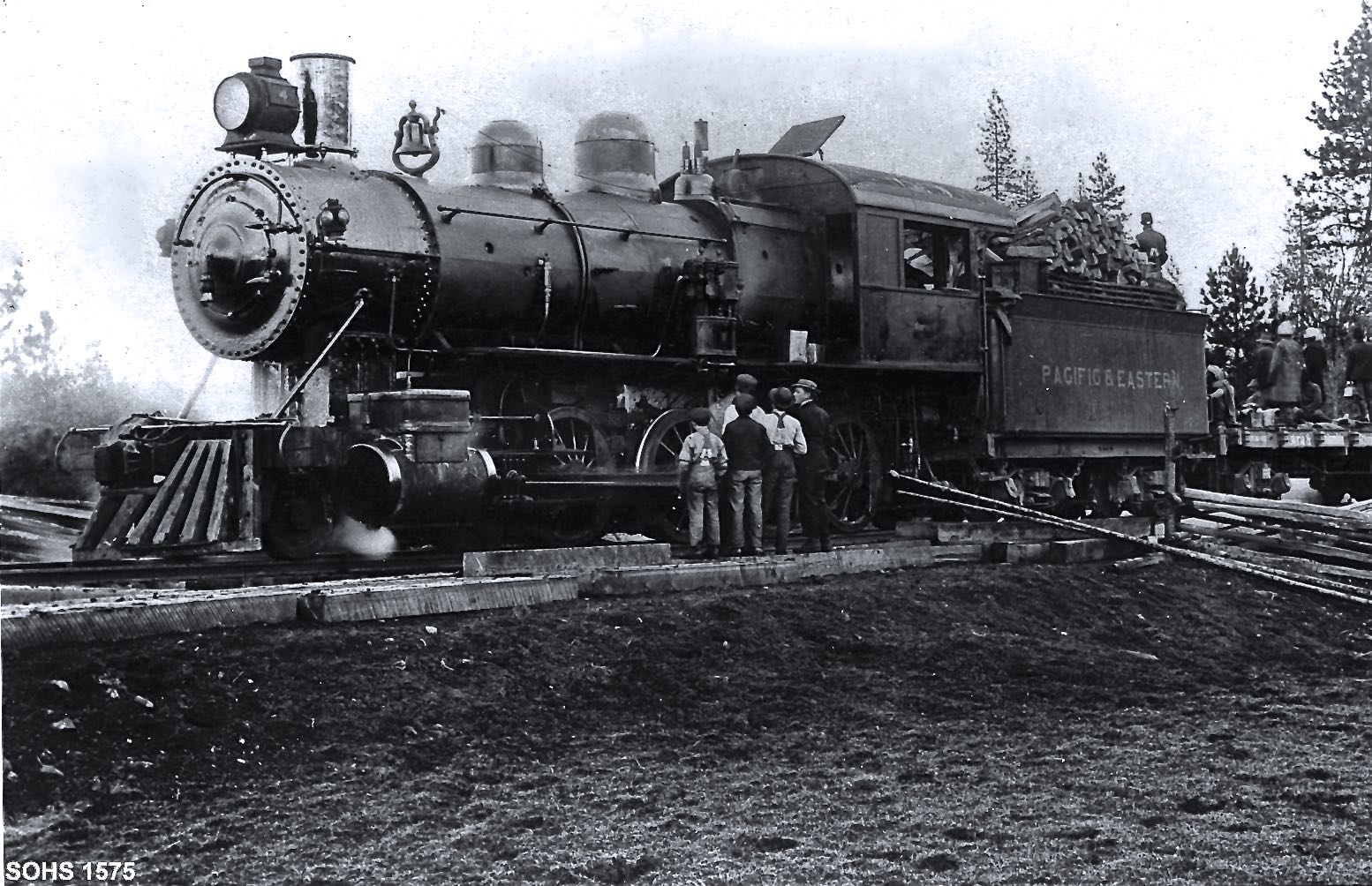
November 6, 1910 newspaper clipping (SORHS collection)
First Train into Butte Falls November 15, 1910 (Southern Oregon Historical Society #1575)
● A spur line was constructed from the main line south along the east side of Bear Creek to east Main Street where
a new depot was constructed.

One of 3 locomotives operated by the P&E shown parked on a spur near the new depot in Medford. The depot and the ciecus advertising signs faced East Main St.

December 30, 1910 newspaper clipping (SORHS collection)
● Regular train service began moving
over the line on April 1, 1911

The first excursion train into Butte Falls, April 9, 1911 (Southern Oregon Historical Society #4332)

● The original plan was to extend the line across the Cascades to connect to James J. Hills Great Northern RR at Klamath Falls.
● Although the route was surveyed beyond Butte Falls, construction was never continued.
● For most of its existence the P&E operated at a deficit.
● In 1918 the line was allowed to go into receivership and was ordered shut down an sold at auction by the Courts on
January 15, 1919.
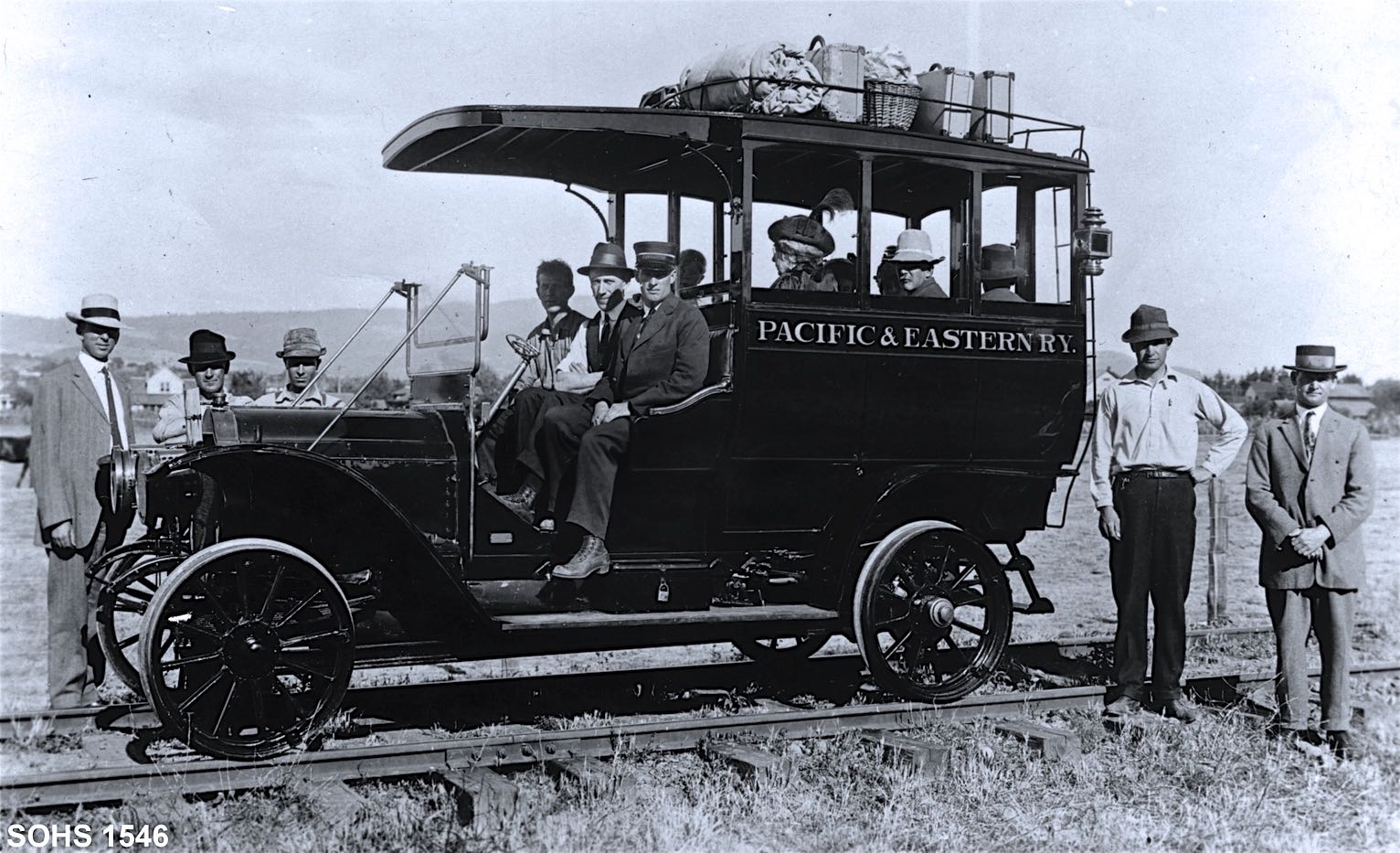
As cost saving measure in the lean years during and after the First World War a motorcar was used to transport passengers and some goods. (Southern Oregon Historical Society #1546)
The Brownlee-Olds Lumber Co.
● In 1920 Mississippi lumberman James Brownlee purchased timber land north of Butte Falls. He also purchased 33 acres near the junction of the P&E and Southern Pacific railroads and began building a mill.
● On August 20th of the same year Millard D. Olds, a Michigan lumberman who had timber holdings east of Butte Falls, purchased the defunct P&E Railroad for around $200,000 to $250,000 (sources differ on the price). He then began the extension of the railroad east from Butte Falls and began limited logging on his holdings in 1921
● Also in 1921 Olds purchased the Four Bit Creek Timber Sale from what was then the Crater National Forest. This was a tract of about 6,000 acres east of his holdings with an estimated 87.5 million board feet of timber.
● Brownlee owned the mill, Olds owned the railroad, and both men had access to timber in the Butte Falls area served by the railroad. A partnership seemed to be to the advantage of both men. The partnership was formalized on April 1, 1922.
● The Brownlee-Olds Lumber Company operated railroad and the mill until May 1924 when entire operation was sold to the John S. Owen Lumber Company of Wisconsin. The Owen family also owned timberland in the Butte Falls Area.
The Owen-Oregon Lumber Company / Medford Logging Company
● The Owen-Oregon Lumber Company was incorporated to operate the Mill and manage the timberland. A separate company (wholly owned by Owen-Oregon) known as the Medford Logging Company was created to operate the Railroad
● Along with the timberland, mill, and railroad, came right to log the Four Bit Creek Timber sale.
● The railroad was extended into the timber sale area in 1924 and full scale logging was started in 1925
● Owen-Oregon started operations with a 2-6-2 Porter rod locomotive originally purchased new by Brownlee-Olds and 40 log cars.
● The roster was soon expanded with the addition 40 more log cars and the purchase of a used 70 ton Willamette geared locomotive and a new Baldwin 75 ton 2-8-2 rod locomotive in 1924 and a new 70 ton Willamette geared locomotive in 1925.
● The geared locomotives would collect the loaded log cars from the landings and deliver them to a transfer point. The Porter locomotive would haul the loads from the transfer point to Derby (west of Butte Falls). The larger Baldwin locomotives would then take the loads from Derby to the mill in Medford.
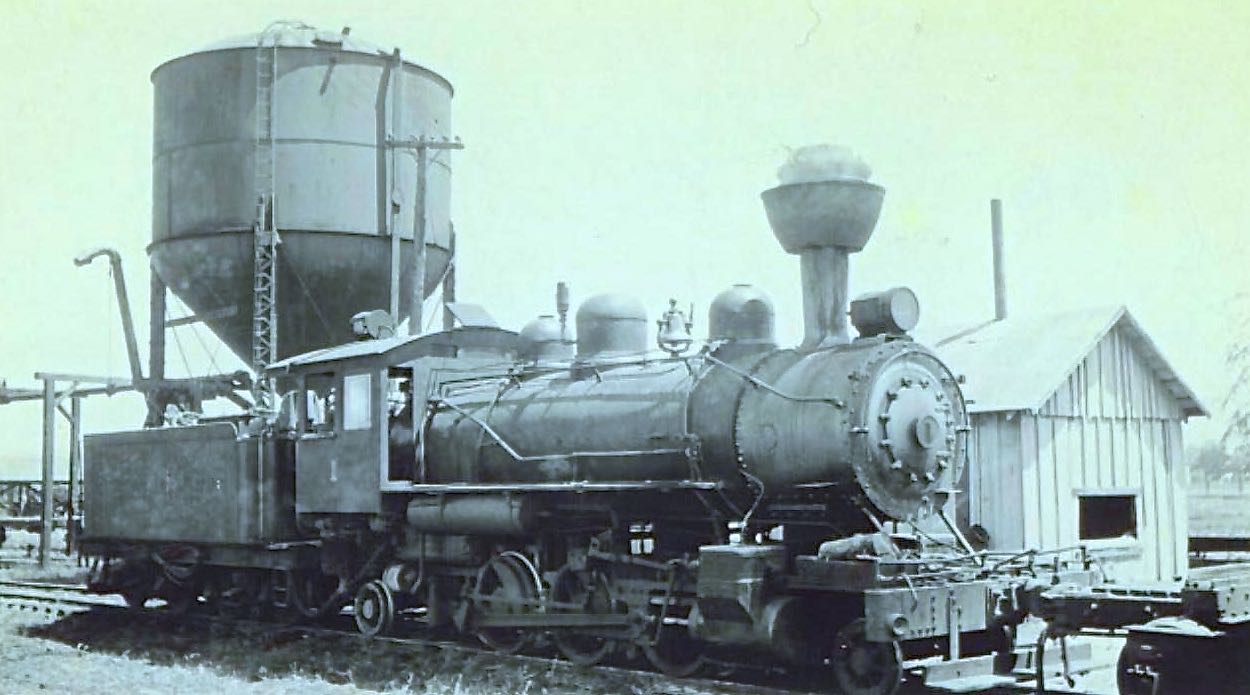
Originally built for Brownlee-Olds as their No. 6, the No. 1 was the first Owen-Oregon Locomotive.
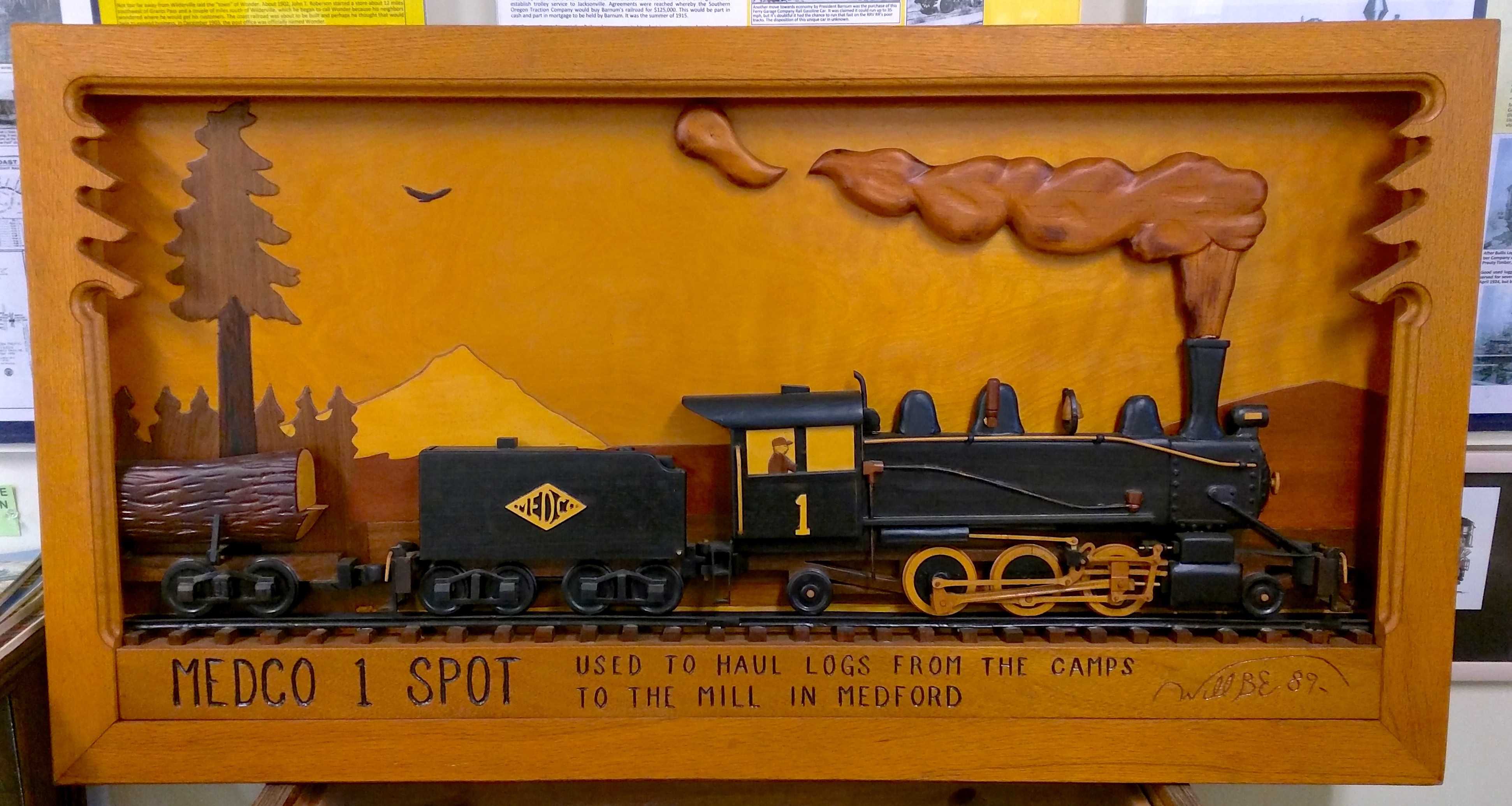
SORHS recently made a major new addition to our museum collection. This 26" x 48" carving was made by William B. Edmondson (1911-1994) who was a lifelong resident of Butte Falls, Or. He is a regionally recognized artist and was featured in articles in the Medford Mail Tribune, the Timber Times, and on Jefferson Public Radio. His carvings have been displayed by local museums, the Oregon Historical Society, and even the Smithsonian.
● Even though Owen-Oregon had an ample supply of available timber it never seemed to make money. High costs and poor markets worked against the company.
● When the country was thrown into the depression the decline was accelerated.
● In 1932 the company went into receivership and the property was sold at public auction and purchased by the creditors. The bond company organized the Medford Corporation to operate the mill.
● The Owen-Oregon Lumber Company was also reorganized at this time as the Owen Oregon Lumber Sales Co. Its purpose was to liquidate the unbonded assets not sold at public auction.
● The Owen Oregon Lumber Sales Co entered into an agreement to use the Medford Corporation logging equipment, railroad, and mill to cut its remaining timber with all profits to go to the bondholders. This arrangement ended in 1935.
The Medford Corporation (MEDCO)
● During the late 1930’s the Medford Corporation (MEDCO) was beginning to show a profit. The railroad was slowly expanded the north accessing new tracts of private and Forest Service timber.
● Unlike the prior cutting practices, this more recent harvest concentrated on the high value large ponderosa pine and sugar pine preserving the smaller trees and lower value species for future growth and harvest and reducing logging cost.
● World War II was a boom time for the timber industry. The MEDCO mill needed to run two full shifts everyday to meet the war demand.
● During this time the railroad reached its maximum expansion and transportation began to evolve to meet the high demand for raw materials.
● Rails were no longer extended to individual landings and trucks were used to transport the logs to a transfer point were they were decked to be loaded on log cars for the trip to Medford.
● In 1945, the 60 acre Daly Pond (now known as Medco Pond) was built 15 miles north of Butte Falls. This provided for longer term storage. Logs were often stock-piled here during the summer and shipped out during the winter to keep the mill supplied during the off season.

The Medford Corporation No. 4 was built by Willamette Iron and Steel Co. in 1925 (Construction No. 18) for the Owen – Oregon Lumber Co. as their #4 locomotive. The Medco No. 4 locomotive was one of 33 geared steam locomotives built by Willamette Iron and Steel between 1923 and 1929. (Willamette builder’s photo, Mallory Hope Ferrell collection)
Built 1952 – Medford Corporation #8
1968 – Magma Arizona # 8. Out of Service 1992, 1995 – Purchased by the Southern Oregon Chapter, NRHS and restored to operating Condition. (Baldwin-Lima-Hamilton builder’s photo. SORHS collection)

● During the 1950’s as trucking became more efficient, MEDCO realized that the era of railroad logging was coming to an end.
● The slower geared locomotives used for the spur logging were eventually used just for switching the log reload sites, relegated to track maintenance work and and/or scrapped.

The Medco no. 2 Willamette in track maintenance service at Camp 4 in 1957. (Vern Goe photograph, John Labbe collection)

Rumor has it that when this wreck occured access in and out of Butte Falls was blocked over night. By the next morning the gas in all of the stuck log trucks had misteriously disappeared.
While the railroad would lose out to trucking in the long term, both lost in this railroad vs. truck encounter that took place in Butte Falls. . (Southern Oregon Historical Society #15592)
● In 1959, the last two remaining geared locomotives were retired. The Medco No. 4 Willamette locomotive pulled an excursion train on its last trip from Butte Falls to Medford.
● That same year, the last reload site was established just west of Butte Falls. Trains continued to run from this site until 1962. The final train of 19 cars was pulled to Medford by the Medco No. 3 Baldwin steam locomotive.
● The track was all pulled up. The steel rail was salvaged and sold for use on a South American railroad. The newer ties were remanufactured into lumber or used for firewood
● Most lf the right-of-way reverted back to the original landowners or their successors except for a short segment than ran from the mill to a new log storage pond that was built between Medford and White City.
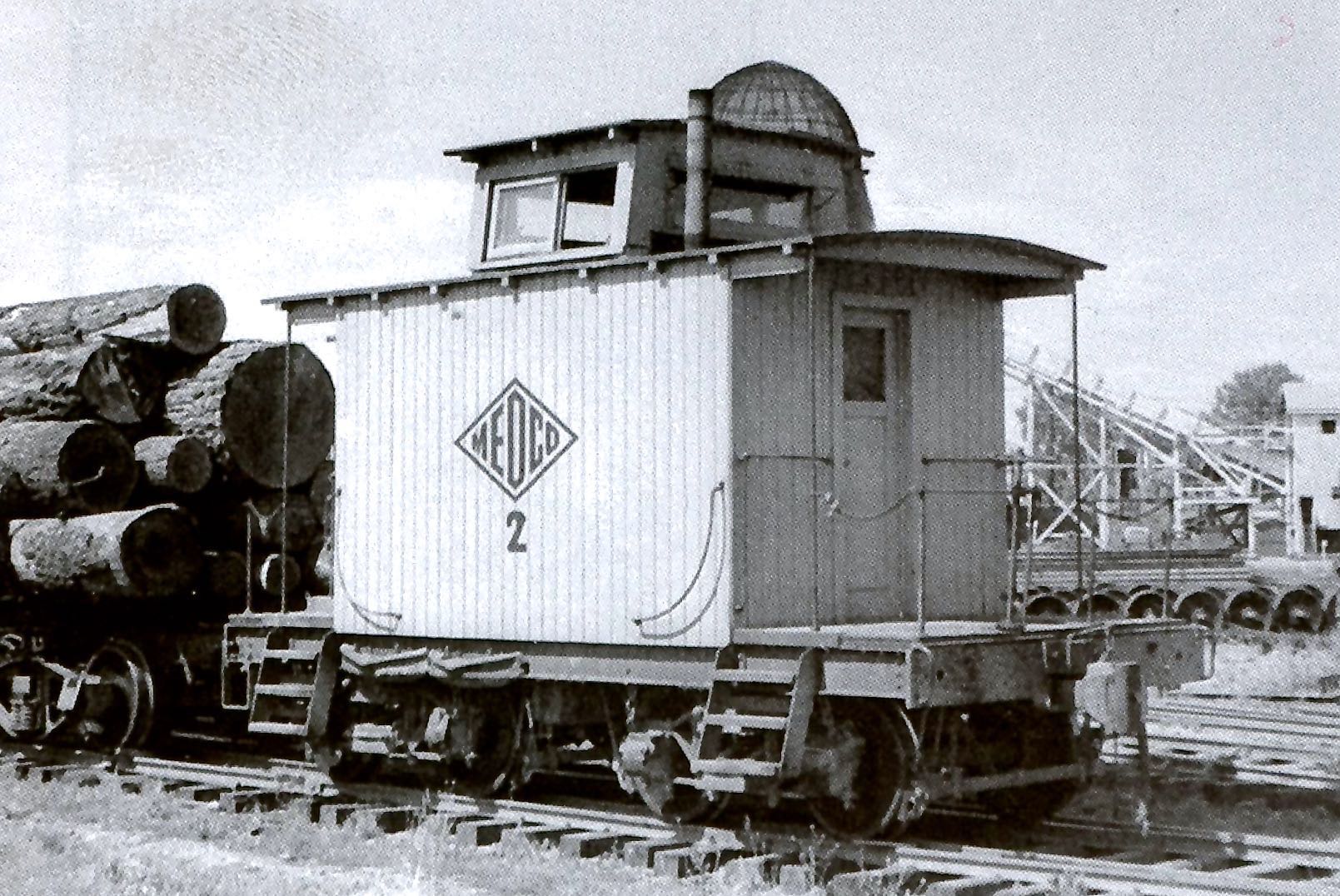
And now a new history begins with the development of the
Butte Falls Scenic Railway.
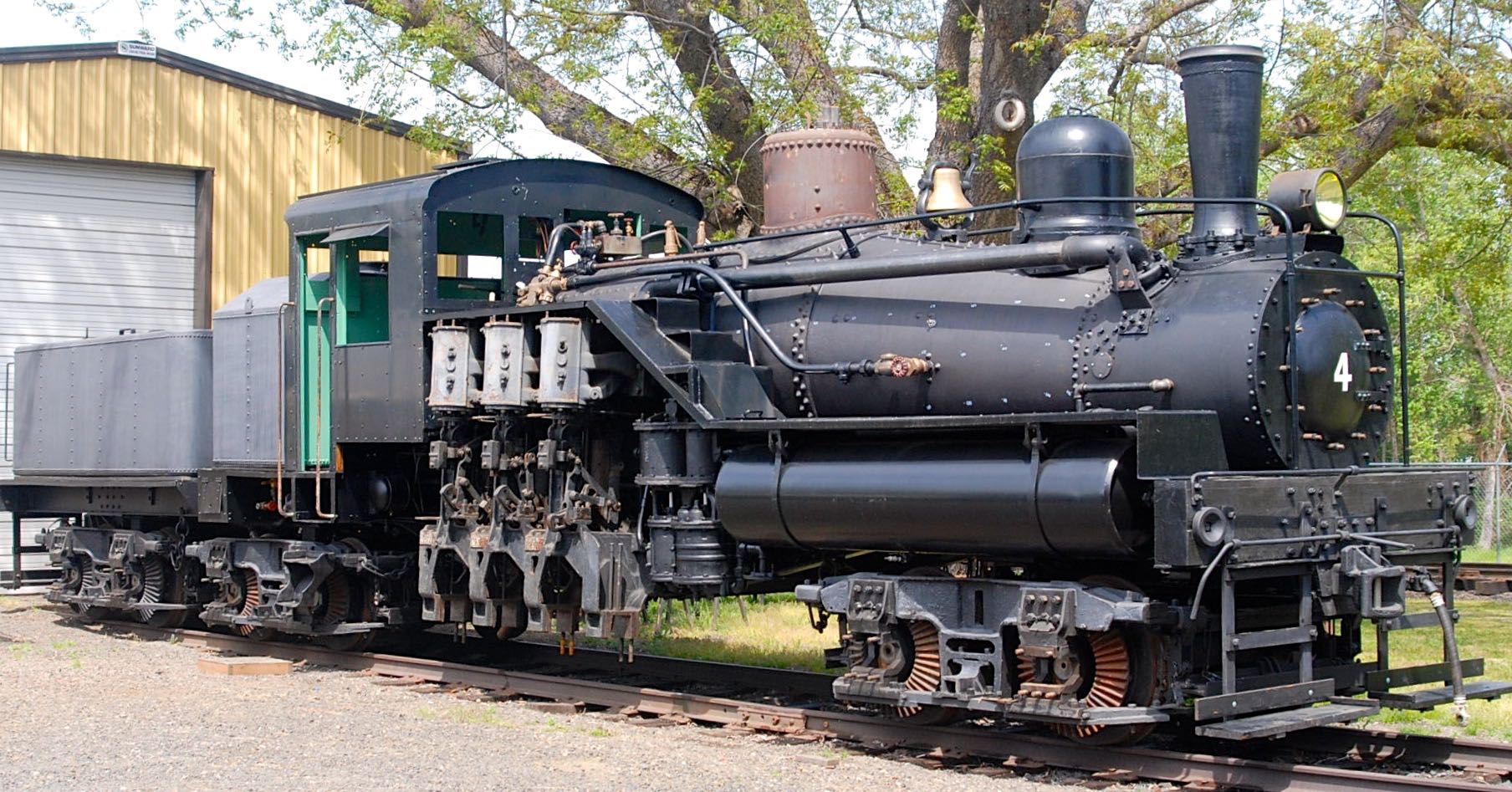
Official project website of the Southern Oregon Railway Historical Society & the Town of Butte Falls, Oregon
Copyright 2020 by the Southern Oregon Railway Historical Society & the Town of Butte Falls, Oregon

Butte Falls Depot with the first arrival of a train from Eagle Point. Note the water tank above the train. The foundation still exists from this tank next to the truck road.

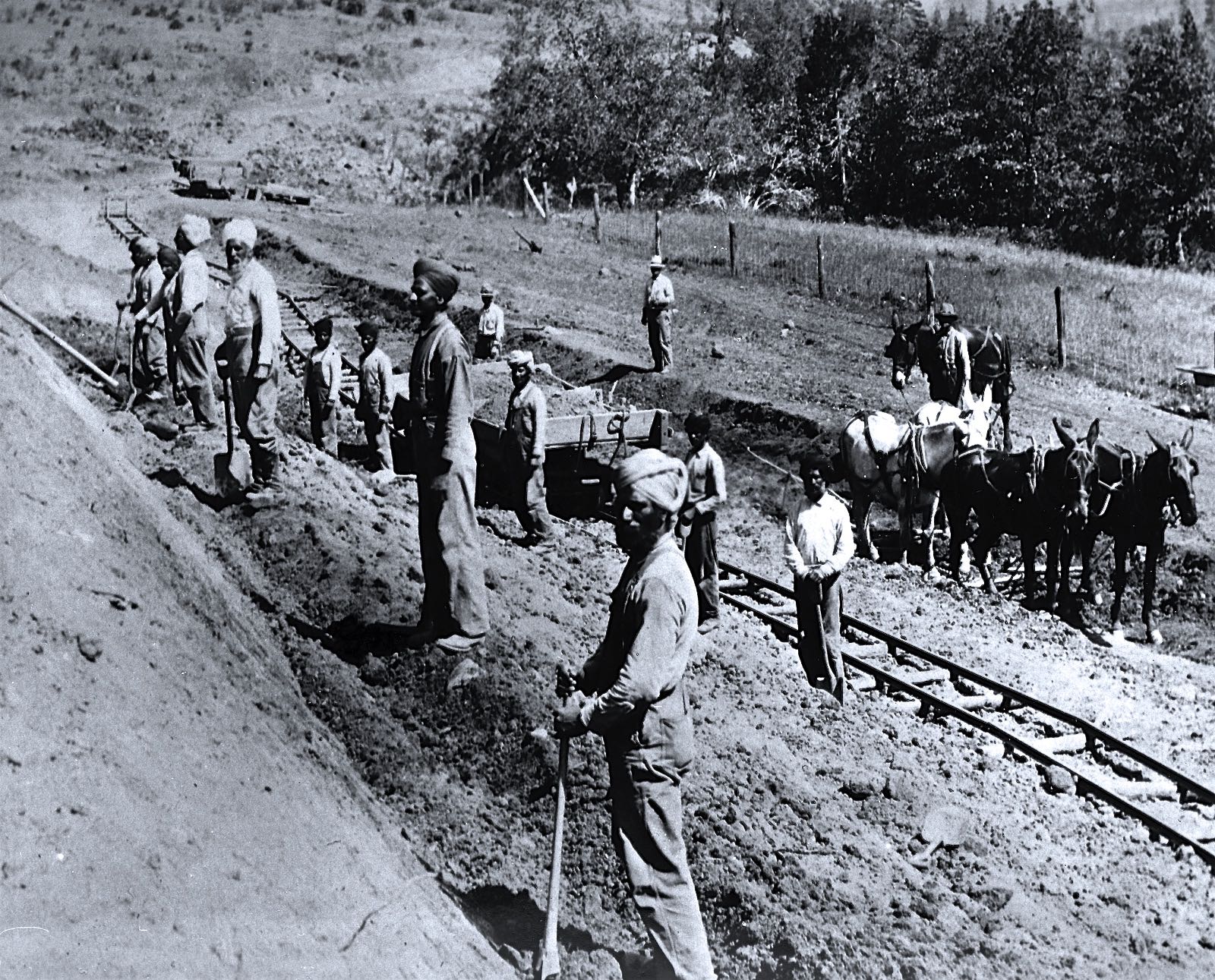
Pacific & Eastern #1 posing at the Southern Pacific depot in Medford, Oregon before thre new P&E depot was built.
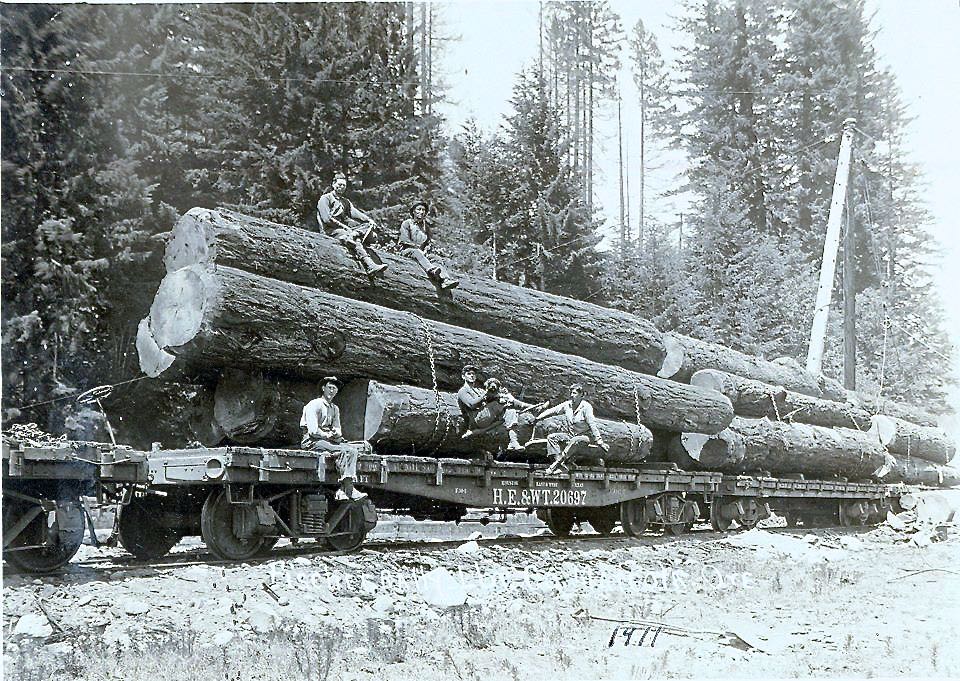
In 1911 the crew poses with a load of large logs bound for Medford. The flat cars were leased from the Houston East & West Texas Railroad.

A Hudson Super 6 leads an excursion out of Butte Falls. Shown here arriving in Eagle Point, Oregon.
● In 1952 MEDCO purchased it first and only diesel locomotive, a 100 ton, 800 horse power Baldwin.
Medco Camp 4 in the snow in 1949.
The Medco main line looking East from the West edge of the town of Butte Falls. You can just see the depot and water tank in the background in the snow in 1949.
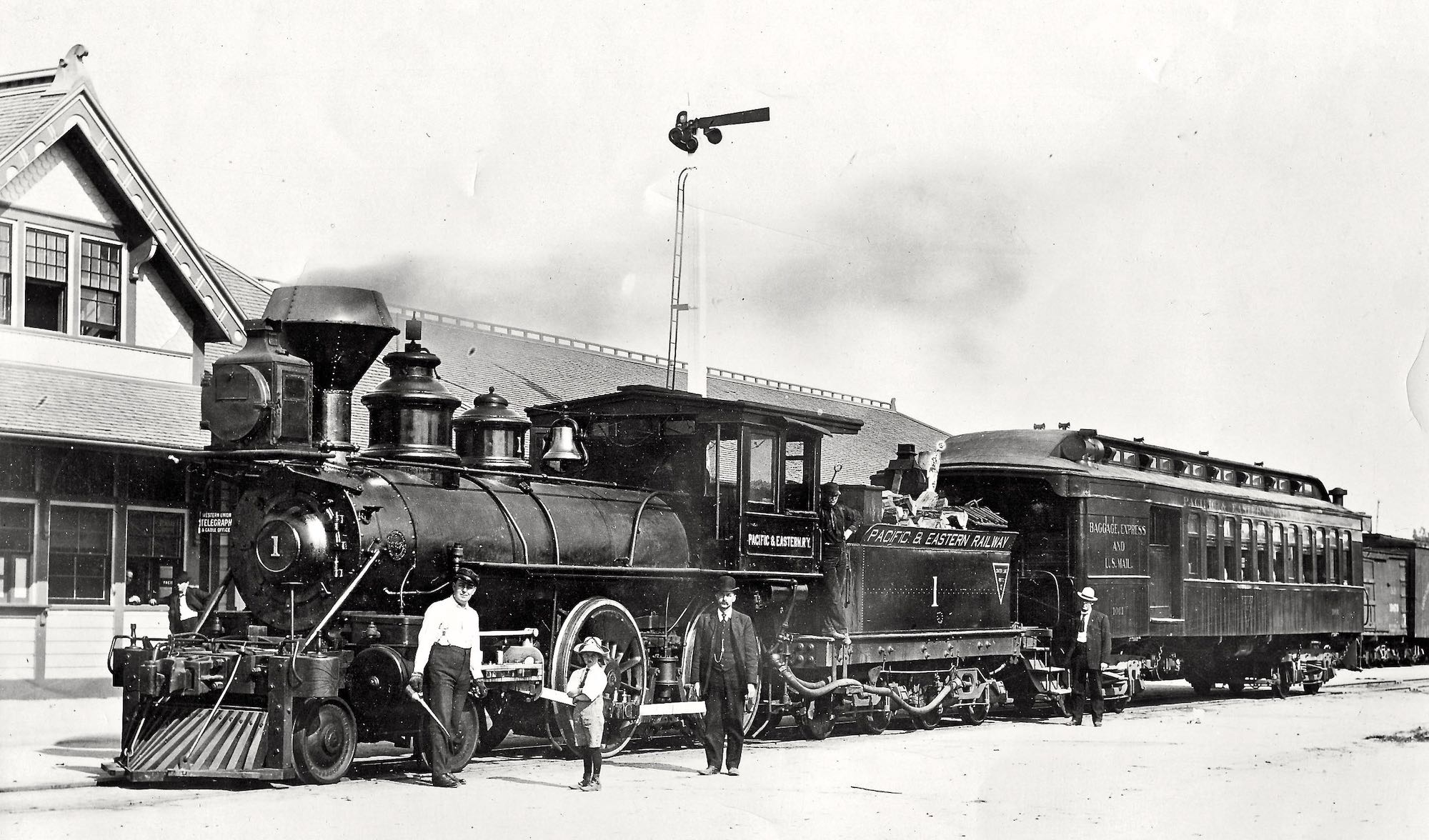


As early as 1889 planning and surveying was being performed to build a narrow gauge railroad from Central Point through Eagle Point to Butte Falls. This project never got past the planning and surveying stage.
The Rogue River Valley Railroad
In 1891 the Rogue River Valley Railroad developed a plan to extend their railroad through Medford and on to Eagle Point. Surveying was performed by J. S. Howard under the direction of general superintendent Graham. By 1893 Mr. C. H. Leadbetter, president of the Rogue River Valley Railroad was developing grand plans to build the railroad past Butte Falls over the Cascades and on in to Klamath Falls but work on the railroad never started.